Why You Mustn't Flush Cat Poop Down Your Toilet - Preserve Your Plumbing System
Why You Mustn't Flush Cat Poop Down Your Toilet - Preserve Your Plumbing System
Blog Article
Here down the page you'll find a good deal of great expertise relating to Don’t flush cat feces down the toilet.

Intro
As cat owners, it's essential to bear in mind just how we deal with our feline pals' waste. While it might seem convenient to flush feline poop down the bathroom, this technique can have detrimental consequences for both the setting and human health and wellness.
Alternatives to Flushing
Fortunately, there are much safer and a lot more liable ways to get rid of feline poop. Think about the complying with alternatives:
1. Scoop and Dispose in Trash
One of the most typical method of taking care of cat poop is to scoop it right into a naturally degradable bag and throw it in the trash. Make certain to use a committed litter scoop and dispose of the waste promptly.
2. Use Biodegradable Litter
Opt for biodegradable pet cat clutter made from products such as corn or wheat. These trashes are environmentally friendly and can be safely gotten rid of in the trash.
3. Hide in the Yard
If you have a lawn, think about burying pet cat waste in an assigned location away from veggie gardens and water resources. Make sure to dig deep adequate to avoid contamination of groundwater.
4. Install a Pet Waste Disposal System
Purchase a pet waste disposal system particularly created for pet cat waste. These systems use enzymes to break down the waste, minimizing odor and environmental impact.
Wellness Risks
In addition to ecological worries, flushing feline waste can also position health and wellness risks to human beings. Feline feces might consist of Toxoplasma gondii, a parasite that can create toxoplasmosis-- a potentially serious illness, especially for expectant women and individuals with damaged body immune systems.
Environmental Impact
Flushing pet cat poop introduces damaging microorganisms and parasites right into the supply of water, posturing a substantial threat to water communities. These contaminants can negatively influence aquatic life and compromise water high quality.
Verdict
Accountable pet dog ownership prolongs past supplying food and shelter-- it also involves correct waste management. By refraining from flushing pet cat poop down the commode and going with alternative disposal approaches, we can decrease our ecological impact and protect human health.
Why Can’t I Flush Cat Poop?
It Spreads a Parasite
Cats are frequently infected with a parasite called toxoplasma gondii. The parasite causes an infection called toxoplasmosis. It is usually harmless to cats. The parasite only uses cat poop as a host for its eggs. Otherwise, the cat’s immune system usually keeps the infection at low enough levels to maintain its own health. But it does not stop the develop of eggs. These eggs are tiny and surprisingly tough. They may survive for a year before they begin to grow. But that’s the problem.
Our wastewater system is not designed to deal with toxoplasmosis eggs. Instead, most eggs will flush from your toilet into sewers and wastewater management plants. After the sewage is treated for many other harmful things in it, it is typically released into local rivers, lakes, or oceans. Here, the toxoplasmosis eggs can find new hosts, including starfish, crabs, otters, and many other wildlife. For many, this is a significant risk to their health. Toxoplasmosis can also end up infecting water sources that are important for agriculture, which means our deer, pigs, and sheep can get infected too.
Is There Risk to Humans?
There can be a risk to human life from flushing cat poop down the toilet. If you do so, the parasites from your cat’s poop can end up in shellfish, game animals, or livestock. If this meat is then served raw or undercooked, the people who eat it can get sick.
In fact, according to the CDC, 40 million people in the United States are infected with toxoplasma gondii. They get it from exposure to infected seafood, or from some kind of cat poop contamination, like drinking from a stream that is contaminated or touching anything that has come into contact with cat poop. That includes just cleaning a cat litter box.
Most people who get infected with these parasites will not develop any symptoms. However, for pregnant women or for those with compromised immune systems, the parasite can cause severe health problems.
How to Handle Cat Poop
The best way to handle cat poop is actually to clean the box more often. The eggs that the parasite sheds will not become active until one to five days after the cat poops. That means that if you clean daily, you’re much less likely to come into direct contact with infectious eggs.
That said, always dispose of cat poop in the garbage and not down the toilet. Wash your hands before and after you clean the litter box, and bring the bag of poop right outside to your garbage bins.
https://trenchlesssolutionsusa.com/why-cant-i-flush-cat-poop/

As a keen person who reads about Can You Flush Cat Poop Down The Toilet?, I imagined sharing that excerpt was a good idea. If you please set aside a second to promote this blog if you enjoyed it. Thank you for taking the time to read it.
Book-Now Report this page